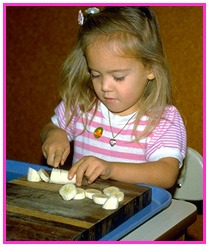III. CARE OF THE PERSON
PREPARING FOOD
LEARNING HOW TO USE THE KITCHEN TOOLS - BLUNT KNIFE
- A child always wears a white kitchen apron when preparing food. He
or she rolls up his or her sleeves.
MATERIAL
Banana
Table, preferably with formica or easily wiped top
Small cutting board
Small blunt knife
Dish for banana slices
LESSON
 Child and teacher wash their hands. The child peels the banana and
puts the skin in the bin for compost heap and the banana on the cutting
board. The teacher shows the child the back of the knife and the cutting
edge of the knife and how the knife is supposed to be held so that he or
she will cut the banana with the cutting edge, holding a finger on the
blunt back. She shows the child how to slice the banana into thin, even
slices and place the slices in the dish.
Child and teacher wash their hands. The child peels the banana and
puts the skin in the bin for compost heap and the banana on the cutting
board. The teacher shows the child the back of the knife and the cutting
edge of the knife and how the knife is supposed to be held so that he or
she will cut the banana with the cutting edge, holding a finger on the
blunt back. She shows the child how to slice the banana into thin, even
slices and place the slices in the dish.
-
- The child will probably want to continue this exercise for some time.
Enough bananas must be available. The slices can be sprinkled with lemon
juice and put in the refrigerator and used later by the teacher in food
preparation or given to the children for snack. The child cutting the banana,
naturally eats slices of the banana. This should not be commented on, unless
there is a real fear of overeating.
-
- When the child has cut as much as she wants, the dish should be put
in the refrigerator. She cuts for the pleasure of learning this skill,
but she also needs to feel that she is working, that what she does is a
help. She must not ever think her work is wasted. The results can be used
for the children's lunch or the teacher can say that she will use them
for her evening meal. The slices are not handed around the class immediately,
as children (a) will be interrupted at work; (b) it is not good for them
to eat between meals. If the child eats any herself, do not interfere.
"Thou shall not muzzle the one that treadeth out the corn," or
if she gives some to a friend, don't interfere.
SUBSEQUENT EXERCISES
- Cutting slices of bread into squares for croutons, etc.
- Cutting cake into squares.
- Cutting soft roles into slices, etc.
Back to Table of Contents